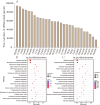Genome-wide identification of the OVATE gene family and revelation of its expression profile and functional role in eight tissues of Rosa roxburghii Tratt
- PMID: 39538133
- PMCID: PMC11558829
- DOI: 10.1186/s12870-024-05775-1
Genome-wide identification of the OVATE gene family and revelation of its expression profile and functional role in eight tissues of Rosa roxburghii Tratt
Abstract
Background: The OVATE gene family is a new class of transcriptional repressors, which play an important regulatory role in plant growth and development. Many studies have proved that the OVATE gene family can regulate the development of plant tissues and organs and resist stress, but its quantity and functional role in Rosa roxburghii remain unknown.
Results: In this study, 14 OVATE family members were identified by re-annotating the genome of Rosa roxburghii, and these members were unevenly distributed on 6 chromosomes. Evolutionary analysis indicated that these family members were classified into three groups. In their promoter regions, many hormone-related cis-acting elements such as ABA, GA, and MeJA were identified. Segmental duplication is an important driving force for the expansion of the OVATE family in Rosa roxburghii. Transcriptome sequencing and RT-qPCR analysis showed that OVATE gene family had a specific tissue expression pattern in Rosa roxburghii. For instance, the expression level of gene Rr602241 in leaves was more than 4 times that of other tissues. The gene Rr101515 was highly expressed in FR1 and FR4 stages of fruit tree development, and was highly homologous to the gene regulating fruit shape in tomatoes. These results suggest that members of the OVATE gene family may have diverse functions in different tissues. Furthermore, based on the transcriptome data of eight tissues, a transcriptional regulatory co-expression network of different transcription factors and 14 OVATE genes was constructed.
Conclusion: In conclusion, our study provides the expression profiles of the OVATE family and reveals the potential functional roles of different members in the growth and development of Rosa roxburghii Tratt.
Keywords: Rosa roxburghii Tratt; Gene expression; OVATE gene family; Tissue growth and development; Transcriptome sequencing.
© 2024. The Author(s).
Conflict of interest statement
Figures









References
-
- Huang M, Xu Q, Deng X-X. l-Ascorbic acid metabolism during fruit development in an ascorbate-rich fruit crop chestnut rose (Rosa roxburghii Tratt). J Plant Physiol. 2014;171(14):1205–16. - PubMed
-
- Su L, Zhang T, Cheng Z-M. Identification of transcription factors contributing to vitamin C synthesis during Rosa roxburghii fruit development by integrating transcriptomics and metabolomics. Hortic Plant J 2024.
-
- Xu L, Yang H, Li C, Liu S, Zhao H, Liao X, Zhao L. Composition analysis of free and bound phenolics in chestnut rose (Rosa roxburghii Tratt.) Fruit by UHPLC-IM-QTOF and UPLC-QQQ. Lwt 2023, 185.
MeSH terms
Substances
Grants and funding
LinkOut - more resources
Full Text Sources

